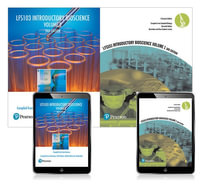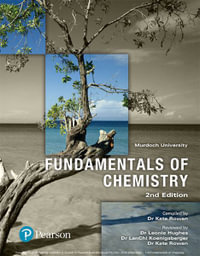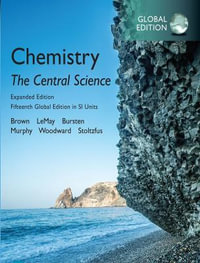
Modern Physics
3rd Edition
By: Raymond Serway, Clement Moses, Curt Moyer
Paperback | 23 October 2020 | Edition Number 3
At a Glance
648 Pages
Revised
25.5 x 19.3 x 1.7
Paperback
RRP $199.95
$155.75
22%OFF
or 4 interest-free payments of $38.94 with
orThe authors clarify and show support for these theories through a broad range of current applications and examples-attempting to answer questions such as:
To pique student interest, brief sketches of the historical development of twentieth-century physics such as anecdotes and quotations from key figures as well as interesting photographs of noted scientists and original apparatus are integrated throughout.
The Third Edition has been extensively revised to clarify difficult concepts and thoroughly updated to include rapidly developing technical applications in quantum physics. To complement the analytical solutions in the text and to help students visualize abstract concepts, the new edition also features free online access to QMTools, new platform-independent simulation software created by co-author, Curt Moyer, and developed with support from the National Science Foundation.
Icons in the text indicate the problems designed for use with the software.
About the Authors
Raymond A. Serway is an emeritus at James Madison University. He earned his doctorate at Illinois Institute of Technology. Among his accolades, he has received an honorary doctorate degree from his alma mater, Utica College, the 1990 Madison Scholar Award at James Madison University where he taught for 17 years, the 1977 Distinguished Teaching Award at Clarkson University and the 1985 Alumni Achievement Award from Utica College. As a Guest Scientist at the IBM Research Laboratory in Zurich, Switzerland, Dr. Serway worked with K. Alex Müller, who shared the 1987 Nobel Prize in Physics. He was also a visiting scientist at Argonne National Laboratory where he collaborated with his mentor and friend, the late Sam Marshall.
Clement J. Moses is Emeritus Professor of Physics at Utica College. He was born and brought up in Utica, NY, and holds an A.B. from Hamilton College, an M.S. from Cornell University, and a Ph.D. from State University of New York at Binghamton. He has over 30 years of science writing and teaching experience at the college level, and is a co-author of College Physics, 6th edition, with Serway and Faughn. His research work, both in industrial and university settings, has dealt with defects in solids, solar cells, and the dynamics of atoms at surfaces. In addition to science writing, Dr. Moses enjoys reading novels, gardening, cooking, singing, and going to operas.
Curt A. Moyer is Professor and Chair of the Department of Physics and Physical Oceanography at the University of North Carolina-Wilmington. He came to UNC-Wilmington in 1999. Before that, he had been a member of the Physics Department at Clarkson University since 1974. He has written numerous research articles in the fields of condensed matter physics and surface science. Dr. Moyer is an experienced teacher and an advocate for the uses of computers in education. He prepared the web-based QMTools software that accompanies this text.
Special Relativity. The Principle of Relativity. The Michelson-Morley Experiment. Postulates of Special Relativity. Consequences of Special Relativity. The Lorentz Transformation. Spacetime and Causality. Summary.
2. RELATIVITY II.
Relativistic Momentum and Relativistic Form of Newton''s Laws. Relativistic Energy. Mass as a Measure of Energy. Conservation of Relativistic Momentum, Mass, and Energy. General Relativity. Summary. Web Essay 1: The Renaissance of General Relativity.
3. THE QUANTUM THEORY OF LIGHT.
Hertz''s Experiments-Light as an Electromagnetic Wave. Blackbody Radiation. The Rayleigh-Jeans Law and Planck''s Law (Online). Light Quantization and the Photoelectric Effect. The Compton Effect and X-Rays. Particle-Wave Complementarity. Does Gravity Affect Light? (Optional). Summary. Web Appendix 1: Calculation of the Number of Modes of Waves in a Cavity.
4. THE PARTICLE NATURE OF MATTER.
The Atomic Nature of Matter. The Composition of Atoms. The Bohr Atom. Bohr''s Correspondence Principle, or Why is Angular Momentum Quantized? Direct Confirmation of Atomic Energy Levels: The Franck-Hertz Experiment. Summary.
5. MATTER WAVES.
The Pilot Waves of de Broglie. The Davisson-Germer Experiment. TEM and SEM microscopes. Wave Groups and Dispersion. Fourier Integrals (Optional). The Heisenberg Uncertainty Principle. If Electrons Are Waves, What''s Waving? The Wave-Particle Duality. A Final Note. Summary.
6. QUANTUM MECHANICS IN ONE DIMENSION.
The Born Interpretation. Wavefunction for a Free Particle. Wavefunctions in the Presence of Forces. The Particle in a Box. CCD''s. The Finite Square Well (Optional). The Quantum Oscillator. Expectation Values. Observables and Operators. Summary.
7. TUNNELING PHENOMENA.
The Square Barrier. Barrier Penetration: Some Applications. Summary. Essay: The Scanning Tunneling Microscope.
8. QUANTUM MECHANICS IN THREE DIMENSIONS.
Particle in a Three-Dimensional Box. Central Forces and Angular Momentum. Space Quantization. Quantization of Angular Momentum and Energy (Optional). Atomic Hydrogen and Hydrogen-like Ions. Summary.
9. ATOMIC STRUCTURE.
Orbital Magnetism and the Normal Zeeman Effect. The Spinning Electron. The Spin-Orbit Interaction and Other Magnetic Effects. Exchange Symmetry and the Exclusion Principle. Electron Interactions and Screening Effects (Optional). The Periodic Table. X-Ray Spectra and Moseley''s Law. Summary.
10. STATISTICAL PHYSICS.
The Maxwell-Boltzmann Distribution. Quantum Statistics, Indistinguishability, and the Pauli Exclusion Principle. Applications of Bose-Einstein Statistics. An Application of Fermi-Dirac Statistics: The Free-Electron Gas Theory of Metals. Summary. Essay: Laser Manipulation of Atoms.
11. MOLECULAR STRUCTURE.
Bonding Mechanisms: A Survey. Molecular Rotation and Vibration. Molecular Spectra. Electron Sharing and the Covalent Bond. Bonding in Complex Molecules (Optional). Summary. Web Appendix 2: Overlap Integrals of Atomic Wavefunctions.
12. THE SOLID STATE.
Bonding in Solids. Classical Free-Electron Model of Metals. Quantum Theory of Metals. Band Theory of Solids. Semiconductor Devices. Lasers. Superconductivity. Summary. Web Essay 2: The Invention of the Laser. Web Essay 3: Photovoltaic Conversion.
13. NUCLEAR STRUCTURE.
Some Properties of Nuclei. Binding Energy and Nuclear Forces. Nuclear Models. Radioactivity. Decay Processes. Natural Radioactivity. Summary.
14. NUCLEAR PHYSICS APPLICATIONS.
Nuclear Reactions. Reaction Cross Section. Interactions Involving Neutrons. Nuclear Fission. Nuclear Reactors. Nuclear Fusion. Recent Fusion Energy Developments. Interaction of Particles with Matter. Radiation Damage in Matter. Radiation Detectors. Summary.
15. ELEMENTARY PARTICLES.
The Fundamental Forces in Nature. Positrons and Other Antiparticles. Mesons and the Beginning of Particle Physics. Classification of Particles. Conservation Laws. Strange Particles and Strangeness. Neutrino Oscillations. How Are Elementary Particles Produced and Particle Properties Measured? The Eightfold Way. Quarks. Colored Quarks, or Quantum Chromodynamics. Electroweak Theory and the Standard Model. The Cosmic Connection. Problems and Perspectives. Summary. Essay: How to Find a Top Quark.
16. COSMOLOGY (AVAILABLE ONLINE ONLY).
The Discovery of the Expanding Universe. Observation of Radiation from the Big Bang. Spectrum Emitted by a Receding Blackbody. Prediction of Primordial Helium. Will the Universe Expand Forever? Critical Density and Missing Mass. Supersymmetry. The Inflationary Universe. Summary.
ISBN: 9780357671023
ISBN-10: 0357671023
Published: 23rd October 2020
Format: Paperback
Language: English
Number of Pages: 648
Audience: College, Tertiary and University
Publisher: Brooks/Cole ISE
Country of Publication: GB
Edition Number: 3
Edition Type: Revised
Dimensions (cm): 25.5 x 19.3 x 1.7
Weight (kg): 1.19
Shipping
| Standard Shipping | Express Shipping | |
|---|---|---|
| Metro postcodes: | $9.99 | $14.95 |
| Regional postcodes: | $9.99 | $14.95 |
| Rural postcodes: | $9.99 | $14.95 |
Orders over $79.00 qualify for free shipping.
How to return your order
At Booktopia, we offer hassle-free returns in accordance with our returns policy. If you wish to return an item, please get in touch with Booktopia Customer Care.
Additional postage charges may be applicable.
Defective items
If there is a problem with any of the items received for your order then the Booktopia Customer Care team is ready to assist you.
For more info please visit our Help Centre.
You Can Find This Book In

Crafting & Executing Strategy
24th Edition - The Quest for Competitive Advantage: Concepts and Cases ISE
Paperback
RRP $169.95
$136.75
OFF
























